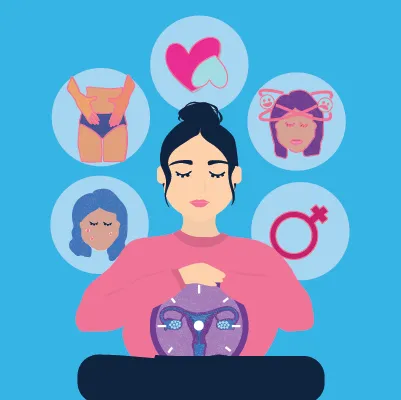Feb 04, 2022
Healthy Ovaries & Ovarian Cancer Awareness Month
February is Ovarian Cancer Awareness Month in Australia – a whole month dedicated to sharing information and stories from women affected by the disease.
While many of us may have set New Year’s resolutions around self-improvement or wellness, when it comes to our ovaries, they’re often a little ‘out of sight, out of mind’.
It’s easy to take things for granted when they’re working well, especially healthy ovaries. However, our bodies are complex things, and sometimes, we might not realise something’s up until it becomes a bigger issue.
If there’s one thing we’ve learnt in the past year or two, it’s that health is so important. Let’s get on the front foot and show some love to our favourite egg-producing organs by raising ovarian cancer awareness!
What do healthy ovaries do?
Ovaries are the oval-shaped pair of organs found on each side of the pelvic wall. If you picture your classic sex-ed diagram, they’re the large grape-looking things attached to the fallopian tubes.
Ovaries are responsible for the female hormones, oestrogen and progesterone – the MVPs of maintaining the health and development of the female reproductive system – and produce ‘ova’ (the female egg cells).
When we hit puberty, the ovaries release an egg each month during the ovulation stage of our cycle. The egg travels down the fallopian tubes and, if it’s fertilised by sperm, can result in pregnancy. If no sperm comes to the party, the egg is shed along with the uterine lining during menstruation.
When a woman goes through menopause, her ovaries stop releasing eggs and make far lower levels of hormones.
How to look after your ovaries
A great way to maintain healthy ovaries is through a healthy diet and exercise, which are always good to improve general wellbeing and may help to regulate your monthly flow.
Check in with your GP if anything feels out of the ordinary (for example, your period goes ‘missing’, is unusually irregular or you feel any pain in your abdomen). They’ll look into your hormone levels and can monitor whether anything’s askew.
Ovarian health conditions
Doing what we can to look after our bodies and maintain healthy ovaries is a big step in the right direction, but unfortunately, these things aren’t always within our control.
So, what sort of things are we looking out for when it comes to ovarian health?
Polycystic Ovary Syndrome (PCOS) & Ovarian Cysts
Polycystic Ovary Syndrome (PCOS) can appear when the ovaries pump out more androgens than usual (the male hormones that females also make). These little guys can mess with the regular ovulation process and can lead to little follicles growing off our ovaries – these may then form cysts.
We still don’t know the exact cause of PCOS, but insulin resistance, diet and genetics are thought to play a part.
Premature ovarian failure
Premature ovarian failure is when the ovaries stop working as they should (i.e. don’t produce the usual amounts of oestrogen or release eggs regularly). The symptoms are similar to menopause, except that they generally show up in women under 40.
Symptoms can include:
- These include irregular periods
- Hot flashes
- Night sweats
- Vaginal dryness
- Difficulty falling pregnant
Premature ovarian failure can lead to infertility and osteoporosis, although women with the condition might still have periods on and off and may still fall pregnant.
If you’ve missed your period for 3 months or more, it’s a good idea to check in with your health practitioner and see if it’s something to look into.
Ovarian Torsion
Ovarian torsion is the twisting of the ovary – and it’s about as fun as it sounds!
It happens when the ovary becomes entangled around its supporting tissues and cuts off the blood supply to the organs.
While it’s uncommon, it is serious and if not treated can result in losing an ovary. So if you feel sudden and severe pain in your lower abdomen, cramping and/or nausea, get to a hospital ASAP!
Ovarian cancer
About 1,500 Australian women are diagnosed with ovarian cancer each year. But for the eighth most common cancer type in Australia, most of us are in the dark about what ovarian cancer actually means.
Starting with the basics – ovarian cancer is the general term used to describe a cancerous tumour that occurs in either one or both ovaries.
Ovarian cancer symptoms and signs
It’s a difficult one to diagnose in its early stages because the symptoms of ovarian cancer are similar to a lot of common illnesses. These can include:
- increased abdominal size or constant bloating
- abdominal or lower tummy pain
- needing to wee often
- feeling full even after only eating a small amount
- lower back pain
- excessive fatigue
- unexplained weight gain or weight loss
- bleeding after sex or pain during
- irregular periods
- indigestion or nausea
If you have concerns about any of these symptoms, the Ovarian Cancer Australia website recommends tracking them in a diary to take to your doc to investigate further. They’ve even made things easy for us with a handy diary template you can download.
Risk factors of ovarian cancer
The main risk factor is age, as it’s most-commonly diagnosed in women over 50. The average age for diagnosis is 64, but it can still occur in younger women.
Hereditary factors such as having the BRCA1 or BRCA2 genes, being a woman of Ashkenazi Jewish descent (and therefore, having a higher incidence of BRCA mutations than the general population) or having a family history of ovarian, breast, colorectal or endometrial cancers can also increase the risk of developing ovarian cancer.
Other risk factors include:
- having endometriosis, diabetes or previously having breast cancer
- Being overweight
- Using hormone replacement therapies
- Smoking
- Women who haven’t had children are at a slightly higher risk.
Diagnosis and treatment of ovarian cancer
Unfortunately, there isn’t any early detection test yet to screen for ovarian cancer, so checking in with yourself, looking out for any symptoms and knowing about any family history or predisposition to the cancer is a really good place to start.
Check in with your doctor if you’re concerned or wish to learn more. The Ovarian Cancer Australia website is another super helpful resource.
Getting involved in Ovarian Cancer Awareness Month
There’s plenty of ways to get involved in Ovarian Cancer Awareness Month and share some amazing stories of resilience and courage at @ovariancanceroz to inspire and empower us to understand our bodies and take ownership over our health.
Let’s do this.
Love, Libra x
Essity makes no warranties or representations regarding the completeness or accuracy of the information. This information should be used only as a guide and should not be relied upon as a substitute for professional, medical or other health professional advice.







